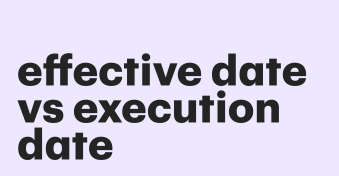An integrated contract is the final writing containing all the terms of several rounds of back-and-forth negotiations, redlining, and reviews on which both negotiating parties agree.
When your company presents an integrated contract, the expectation is that it should contain a consolidation of all written and oral agreements that are tenable and legally binding.
But is an integrated agreement a hindrance or saving grace for your business?
Read on to find out.
Key takeaways
- An integrated contract is a document that contains the final expression of all verbal and written deliberations regarding an agreement.
- If an integrated agreement still allows supplementary evidence, then it is a partially integrated contract. Otherwise, it is a complete integration.
- The court can nullify a complete and final agreement if it contains illegal activity or ambiguity.
What is an integrated contract
An integrated contract is the final written version of a contract that contains all the alterations to previous drafts, as agreed upon by all signatories and parties to the agreement.
In cases of breach of contract, termination, or other conflict, the presiding authority can only refer to the integrated contract.
In contract law, an integrated agreement is also called an integration, final agreement, entire agreement, merger, or fully integrated contract.
What does an integrated contract contain
Integrated contracts are used in business and personal agreements to consolidate the results of negotiations in express language.
The content of an integrated contract supersedes all previous agreements and communication.
Let’s go through the contents of a standard integrated agreement.
Terms of the contract
The terms of a fully integrated contract contain the final expression of all the verbal and written communication that both sides have agreed upon.
In some cases, say construction or real estate law, the terms of the contract need to contain industry standards.
These terms should be consolidated in the executive summary so readers can grasp the gist of the contract at a glance.
Integration clause or merger clause
The integration clause is also called the entire agreement clause.
It is the heart of any fully integrated contract because it clearly spells out that all signatories, underwriters, and witnesses agree to the terms of the contract as is.
Here is an integrated contract example from Apeiron Capital Investment Corp:
“This Agreement supersedes all prior agreements and understandings (whether written or oral) between the Company and the Underwriters, or any of them, with respect to the subject matter hereof.”
You can use this integrated contract model for personal and commercial agreements.
Scope of work and responsibilities
The scope of work covers what every party should do, focusing on their responsibilities, roles, milestones, and project timelines.
Signatories
An integrated agreement should contain the names, signatures, and personal info of all the signatories, as well as their involvement with the contract.
Contract duration
This specifies how long the project is expected to last, including effective start and end dates.
Some integrated contracts also contain stipulations and fines for lateness and failure to reach milestones.
Dispute resolution mechanisms
Integrated contracts provide a conflict resolution mechanism, which often includes the presiding court, intermediaries, and litigation.
If both sides reach an impasse while executing the contract, the court will step in as the tiebreaker for the contract dispute.
Force majeure
Force majeure refers to unforeseen circumstances that could affect the execution of a written contract.
For instance, COVID-19 has been the most famous force majeure over the past few years.
A force majeure clause absolves all parties of responsibility as long as the event is not human-made, out of both parties’ control, or unforeseeable.
Severability and termination terms
Severability indicates the terms of the integrated agreement that are not interconnected.
In other words, if one part of the written agreement is illegal or no longer valid, the rest of the contract remains enforceable.
The terms of termination explain conditions under which any side of written contracts can stop executing their end of the deal without incurring any legal consequences.
Fees and payment plans
This provision is standard in commercial contracts, where one party to the agreement is offering payment for services (e.g., the sale of goods).
To avoid conflicts, both parties need to integrate the final cost and all approved payment methods into a finalized written contract.
Most of the content of integrated agreements are boilerplate clauses.
But the expert legal advice — as well as common sense — would be to revise and customize these contract clauses to your own contractual scenario.
Governing law
Establishing the governing law is important when the parties to both agreements live in different geographical areas.
Some laws that are legal in New York might be illegal elsewhere.
For example, you can sign an integrated agreement for a cannabis dispensary deal.
While the substance is legal in New York, you might be on the cusp of a felony if you attempted the same thing in Iowa, where criminal law in that state prohibits such business enterprises.
Apart from legality, stating the governing law shows the executors of the contract what they are allowed to do.
This is important in construction because of local zoning laws and a million other regulations.
Other potential content includes confidentiality, indemnification, and no-waiver clauses.
What is a partially integrated contract
So far, we’ve been discussing fully integrated contracts.
However, if other external documents supplement the integrated agreement, it is called a partially integrated contract (partial integration).
But this calls into question what sort of supplementary documents could accompany a partially integrated agreement.
That’s where the parol evidence rule comes in, albeit reluctantly.
The parol evidence rule is outside evidence that supports the contents of the initial agreement.
It could be prior written agreements, as well as promises and discussions reflecting the intent of the parties.
Signing a partially integrated contract means that both parties can decide to allow parol evidence if it can resolve the conflict in good faith and prevent litigation.
Furthermore, parol evidence is allowed in cases of ambiguity.
For instance, in the famous “timber” case, the Mississippi Supreme Court allowed parol evidence to clarify that the definition of timber as intended was “merchantable pine timber.”
Outside evidence is also admissible in cases involving illegal activity and invalid contractual conditions.
How an integrated contract can be your saving grace
Adding entire agreement clauses to personal contracts might be overkill.
But when you have multi-million-dollar commercial contracts, you need an integrated agreement to plug every potential legal loophole.
Here are other reasons why you need full integration:
- It eliminates any form of ambiguity or misinterpretation.
- It helps all signatories to understand that what they are signing is final and binding.
- It prevents the introduction of conversations, phone calls, and text messages, which could muddy the waters of intent and purpose.
- It limits the terms of an agreement, conditions, and expectations to the four corners of the document.
The only risk is that the presiding court still has the ultimate power to allow or disregard supplementary documents on a case-by-case basis.
Simplify negotiations by using PandaDoc for your integrated contracts
As you can see by our comprehensive integrated contract definition, an entire agreement clause can rubber-stamp your contract into a fully integrated and valid document.
Barring illegal activity or ambiguity, no other supplementary evidence or additional terms can be introduced by another party to contradict the terms of the agreement.
To keep track of the changes to your completely integrated contract or other commercial agreements, you need a document management solution like PandaDoc.
PandaDoc also provides an integrated contract management system that contains a vast library of contract templates and customizable complete integration clauses.
You can also use the platform to edit, redline, negotiate, and renew contracts with multiple signatories.
Once everyone is on the same page regarding terms, roles, and timelines, they can sign the written document using the click-wrap eSignature solution.
Want to try out PandaDoc for integrated contract management?
Disclaimer
PandaDoc is not a law firm, or a substitute for an attorney or law firm. This page is not intended to and does not provide legal advice. Should you have legal questions on the validity of e-signatures or digital signatures and the enforceability thereof, please consult with an attorney or law firm. Use of PandaDoc services are governed by our Terms of Use and Privacy Policy.


